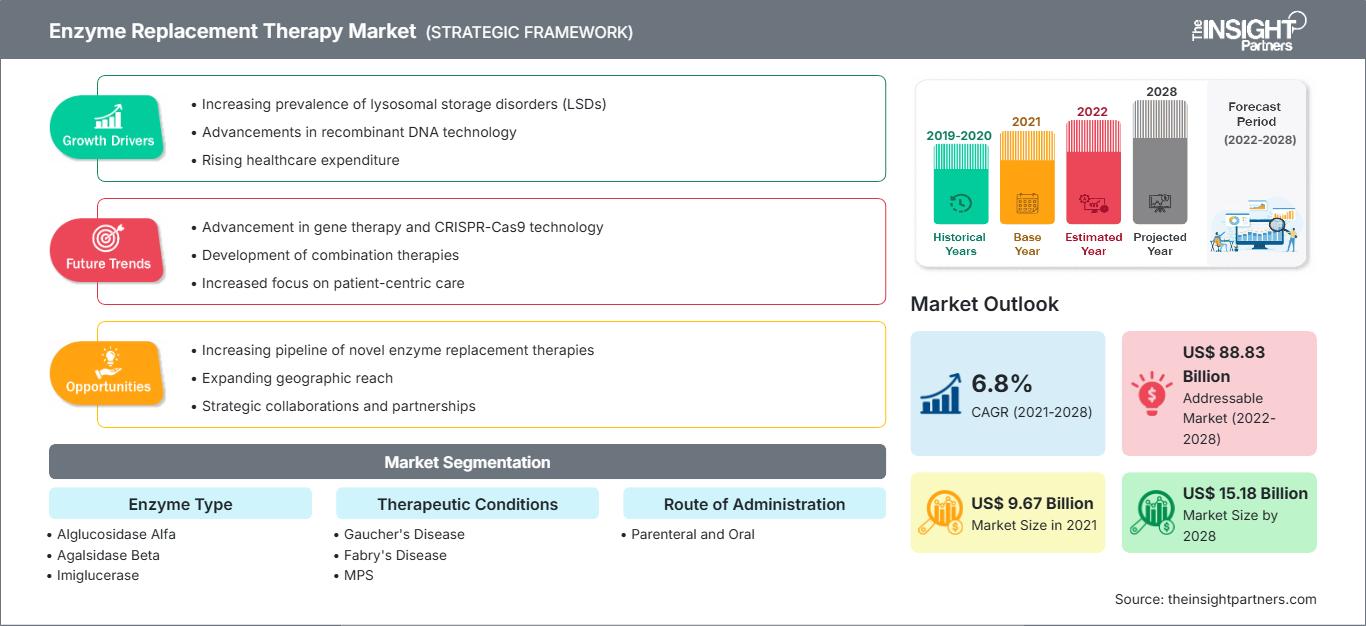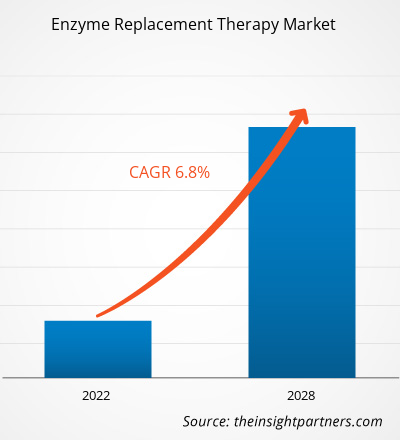酵素補充療法市場は、2021年の96億7,339万米ドルから2028年には151億8,470万米ドルに拡大し、2022年から2028年にかけて6.8%のCAGRで成長すると予測されています。
酵素補充療法(ERT)は、酵素または酵素活性を持つタンパク質を用いて先天性酵素欠乏症を治療するために行われます。治療に必要な酵素の供給源としては、動物、ヒト、組み換え型の工学酵素などがあります。この療法は一般に、ポンペ病、ファブリー病、ゴーシェ病、テイ・サックス病、ハーラー症候群などの希少疾患やリソソーム蓄積疾患に適用されます。最も一般的なERT法はIV注入であり、補充酵素を制御された点滴によって血流に直接投与します。世界の酵素補充療法市場の成長は、リソソーム蓄積症(LSD)の罹患率の上昇と、希少疾病用医薬品指定を受けた薬剤の迅速な規制承認およびその他のマーケティング上の利点に起因しています。しかしながら、市場プレーヤー間の熾烈な競争が市場の成長を阻害しています。
本レポートは、市場動向、技術進歩、市場ダイナミクス、世界の主要市場プレーヤーの競合状況分析など、様々なパラメータを重視しながら、世界の酵素補充療法市場に関する洞察と詳細な分析を提供しています。また、COVID-19パンデミックが全地域の市場に与えた影響についても考察しています。COVID-19パンデミックにより、多くの保健当局はパンデミック関連のケアに注力しました。さらに、2020年3月には、COVID-19患者の負担に対応する病院サービスの不足により、酵素補充療法を必要とする多くの患者が点滴を受け損ないました。ERTを必要とする患者は、入院時や薬剤供給に関して不安を訴えています。また、一部の患者はうつ病や不安の増加を呈していることが研究で明らかになっています。その結果、COVID-19パンデミック中に予定されていた酵素補充療法(ERT)セッションが中断され、市場に悪影響を及ぼしました。
要件に合わせてレポートをカスタマイズ
レポートの一部、国レベルの分析、Excelデータパックなどを含め、スタートアップ&大学向けに特別オファーや割引もご利用いただけます(無償)
酵素補充療法市場: 戦略的洞察

-
このレポートの主要な市場動向を入手してください。この無料サンプルには、市場動向から見積もりや予測に至るまでのデータ分析が含まれます。
地理に基づく洞察
地理別に見ると、世界の酵素補充療法市場は、北米(米国、カナダ、メキシコ)、欧州(フランス、ドイツ、英国、スペイン、イタリア、その他の欧州)、アジア太平洋(中国、インド、日本、オーストラリア、韓国、その他のアジア太平洋)、中東およびアフリカ(サウジアラビア、UAE、南アフリカ、その他の中東・アフリカ)、南米および中米(ブラジル、アルゼンチン、その他の南米および中米)に分類されています。
市場洞察
リソソーム蓄積疾患(LSD)の罹患率の上昇
リソソームは、消化酵素を含む膜結合型細胞小器官です。リソソームは、高分子の異化、リサイクル、シグナル伝達の重要な細胞中枢です。これらの機能に欠陥があると、リソソーム内に高分子が蓄積または貯蔵され、細胞が損傷します。リソソーム蓄積症(LSD)の主な原因は、リソソーム酵素をコードする遺伝子の変異です。また、LSDは、酵素の欠如または欠乏をもたらす先天性代謝エラーとして特徴付けられます。乳幼児や子供は、両親の一方または両方から欠陥遺伝子を受け継ぐ可能性があるため、成人に比べて症状が重くなります。しかし、ここ10年ほどで傾向は変化しており、LSDは成人でより一般的です。
さらに、LSDには、ゴーシェ病、ニーマン・ピック病、ファブリー病、テイ・サックス病、ムコ多糖症(MPS)、ポンペ病など、約70の疾患が含まれます。これらの疾患は個別にはまれですが、全体としては非常に有病率が高く、出生児5,000人に1人の割合で発症しています。多くの国が有病率のパターンを把握するための調査を実施しており、全体的な有病率は上昇傾向にあります。例えば、The Lancet Regional Health誌に掲載された「オーストラリアにおける2009年から2020年までのリソソーム蓄積疾患の有病率」と題する研究があります。調査では、以下の結果が明らかになりました。
- オーストラリアの人口における有病率は1.6倍(生児4,800人中1人)で、1996年に報告された有病率(生児7,700人中1人)より高くなっています。
- ファブリー病が最も多く、全診断の34%を占めています(2020年まで)。
- LSDは、小児期よりも成人期に多く見られます。
したがって、LSDの有病率の上昇と、この疾患を治療するための限られた治療法が、世界の酵素補充療法市場の成長を牽引しています。
酵素タイプに基づく洞察
酵素タイプに基づいて、世界の酵素補充療法市場は、アルグルコシダーゼアルファ、アガルシダーゼベータ、イミグルセラーゼ、イデュルスルファーゼ、ガルスルファーゼ、ベラグルセラーゼに分類されています。アルファ、およびその他の酵素。2021年には、その他の酵素セグメントが最大の市場シェアを占めました。同じセグメントは、2022年から2028年にかけて市場で最高のCAGRを記録すると予想されています。
治療条件に基づく洞察
治療条件に基づいて、世界の酵素補充療法市場は、ゴーシェ病、ファブリー病、ポンペ病、SCID、MPS、およびその他の治療条件に分類されています。ゴーシェ病セグメントは2021年に最大の市場シェアを占め、予測期間中に最高のCAGRを記録すると予想されています。
投与経路に基づく洞察
投与経路に基づいて、世界の酵素補充療法市場は、非経口と経口に分かれています。非経口セグメントは2021年に大きな市場シェアを占め、予測期間中に高いCAGRを記録すると予想されています。
酵素補充療法市場
予測期間全体を通して酵素補充療法市場に影響を与える地域的な傾向と要因については、The Insight Partnersのアナリストが詳細に説明しています。このセクションでは、酵素補充療法市場のセグメントと地域についても、北米、ヨーロッパ、アジア太平洋、中東・アフリカ、中南米に分けて解説しています。
酵素補充療法市場レポートの範囲
| レポート属性 | 詳細 |
|---|---|
| の市場規模 2021 | US$ 9.67 Billion |
| 市場規模別 2028 | US$ 15.18 Billion |
| 世界的なCAGR (2021 - 2028) | 6.8% |
| 過去データ | 2019-2020 |
| 予測期間 | 2022-2028 |
| 対象セグメント |
By 酵素の種類
|
| 対象地域と国 |
北米
|
| 市場リーダーと主要企業の概要 |
|
酵素補充療法市場のプレーヤー密度:ビジネスダイナミクスへの影響を理解する
酵素補充療法市場は、消費者の嗜好の変化、技術の進歩、製品の利点に対する認知度の高まりといった要因によるエンドユーザーの需要増加に牽引され、急速に成長しています。需要の増加に伴い、企業は製品ラインナップの拡充、消費者ニーズへの対応のための革新、そして新たなトレンドの活用を進めており、これが市場の成長をさらに加速させています。

- 入手 酵素補充療法市場 主要プレーヤーの概要
エンドユーザーベースの洞察
エンドユーザーに基づいて、世界の酵素補充療法市場は、病院、点滴センター、その他に分類されます。病院セグメントは2021年に最大の市場シェアを占めました。しかし、点滴センターセグメントは予測期間中に最高のCAGRを記録すると予想されています。
世界の酵素補充療法市場のプレーヤーは、製品の発売と拡張を含む有機的な戦略を採用することで、世界中で事業展開と製品ポートフォリオを拡大し、高まる需要に対応しています。市場に貢献している主要プレーヤーには、武田薬品工業株式会社、サノフィSA、アッヴィ株式会社、バイオマリンファーマシューティカル株式会社、アミカス・セラピューティクス、アレクシオン・ファーマシューティカルズ株式会社(アストラゼネカ)、ヤンセンファーマシューティカルズ株式会社(ジョンソン・エンド・ジョンソン・サービス株式会社)、レコルダティSpA、ファイザー株式会社、およびCHIESIファーマシューティシSpAなどがあります。
- 過去2年間の分析、基準年、CAGRによる予測(7年間)
- PEST分析とSWOT分析
- 市場規模価値/数量 - 世界、地域、国
- 業界と競争環境
- Excel データセット
最新レポート
お客様の声
購入理由
- 情報に基づいた意思決定
- 市場動向の理解
- 競合分析
- 顧客インサイト
- 市場予測
- リスク軽減
- 戦略計画
- 投資の正当性
- 新興市場の特定
- マーケティング戦略の強化
- 業務効率の向上
- 規制動向への対応






















 無料サンプルを入手 - 酵素補充療法市場
無料サンプルを入手 - 酵素補充療法市場